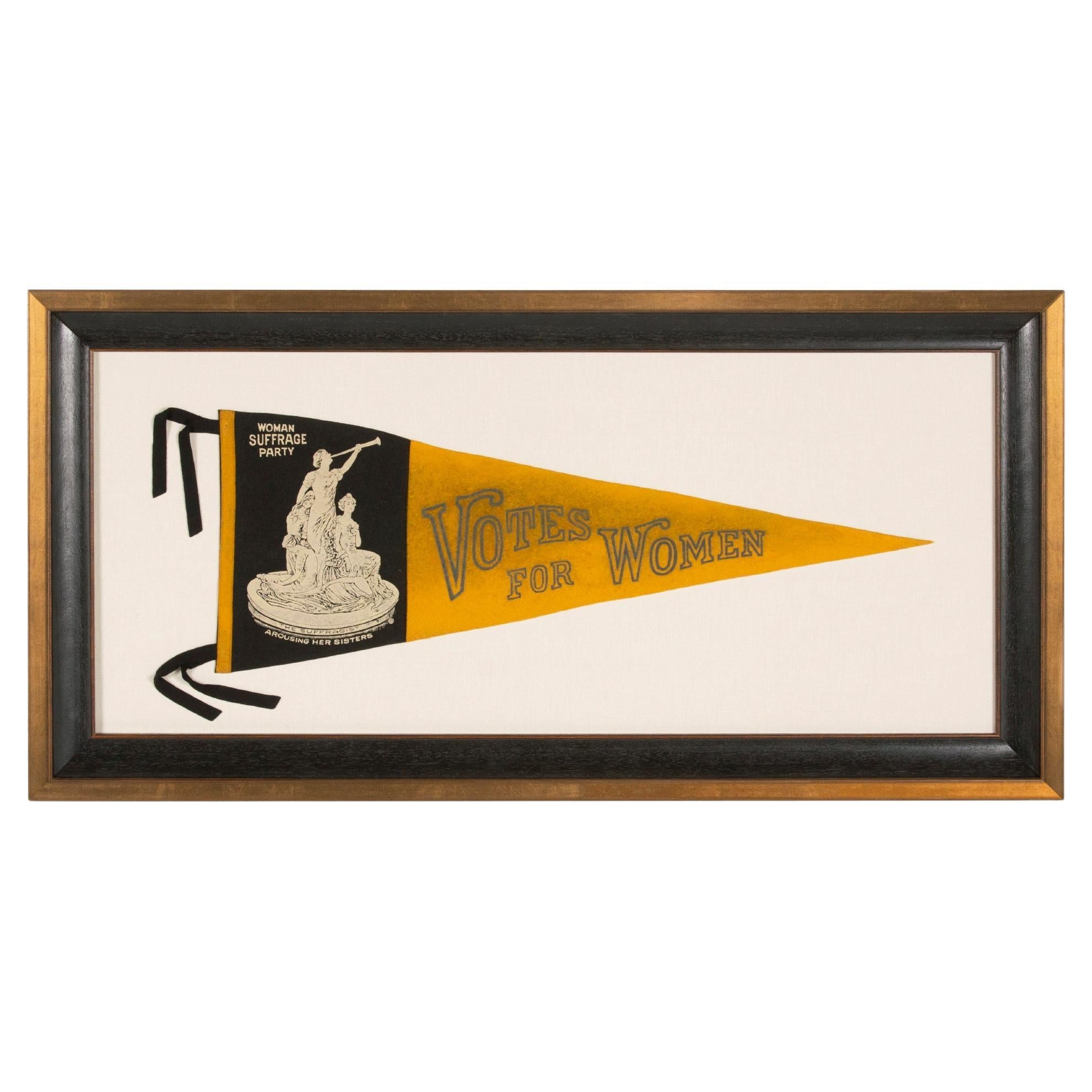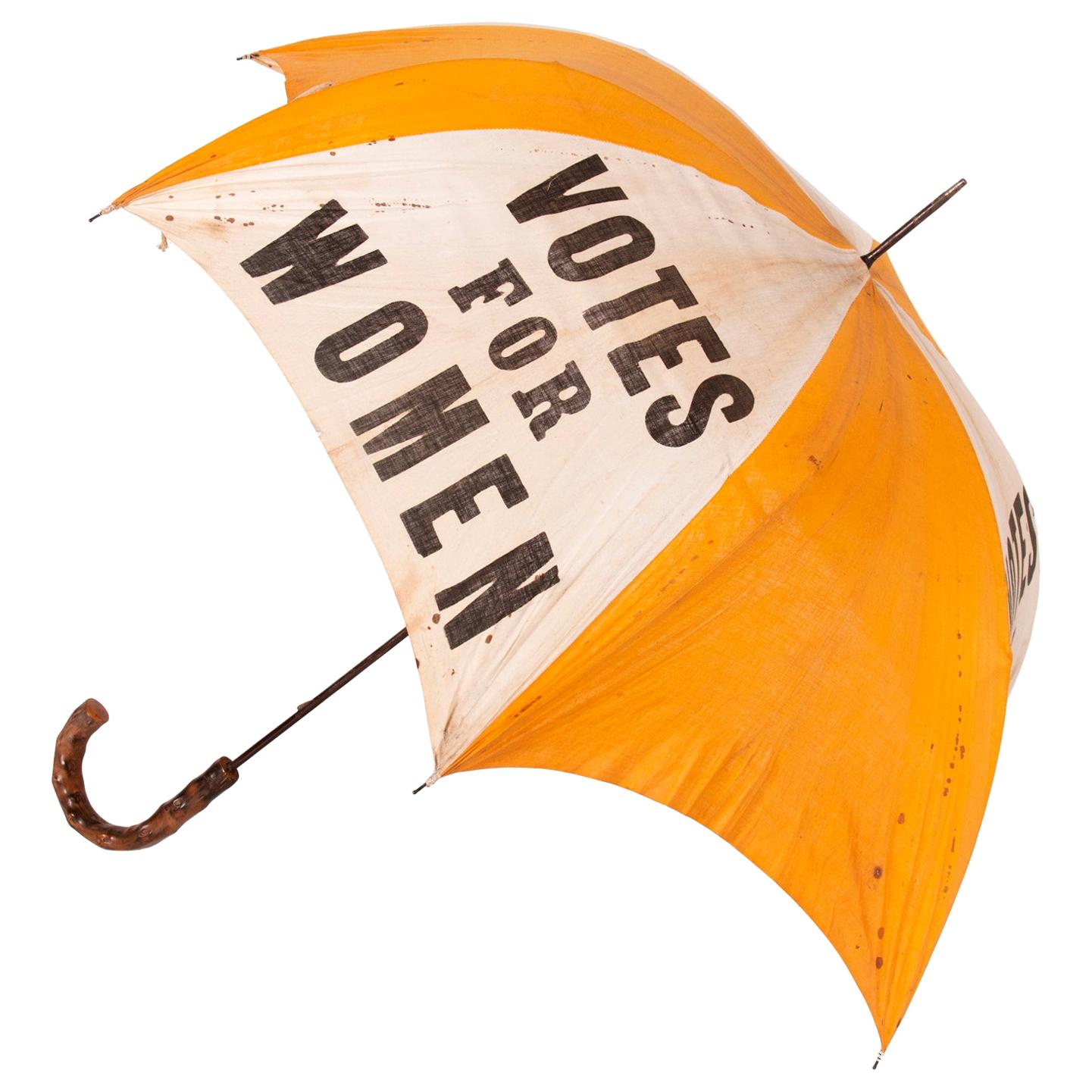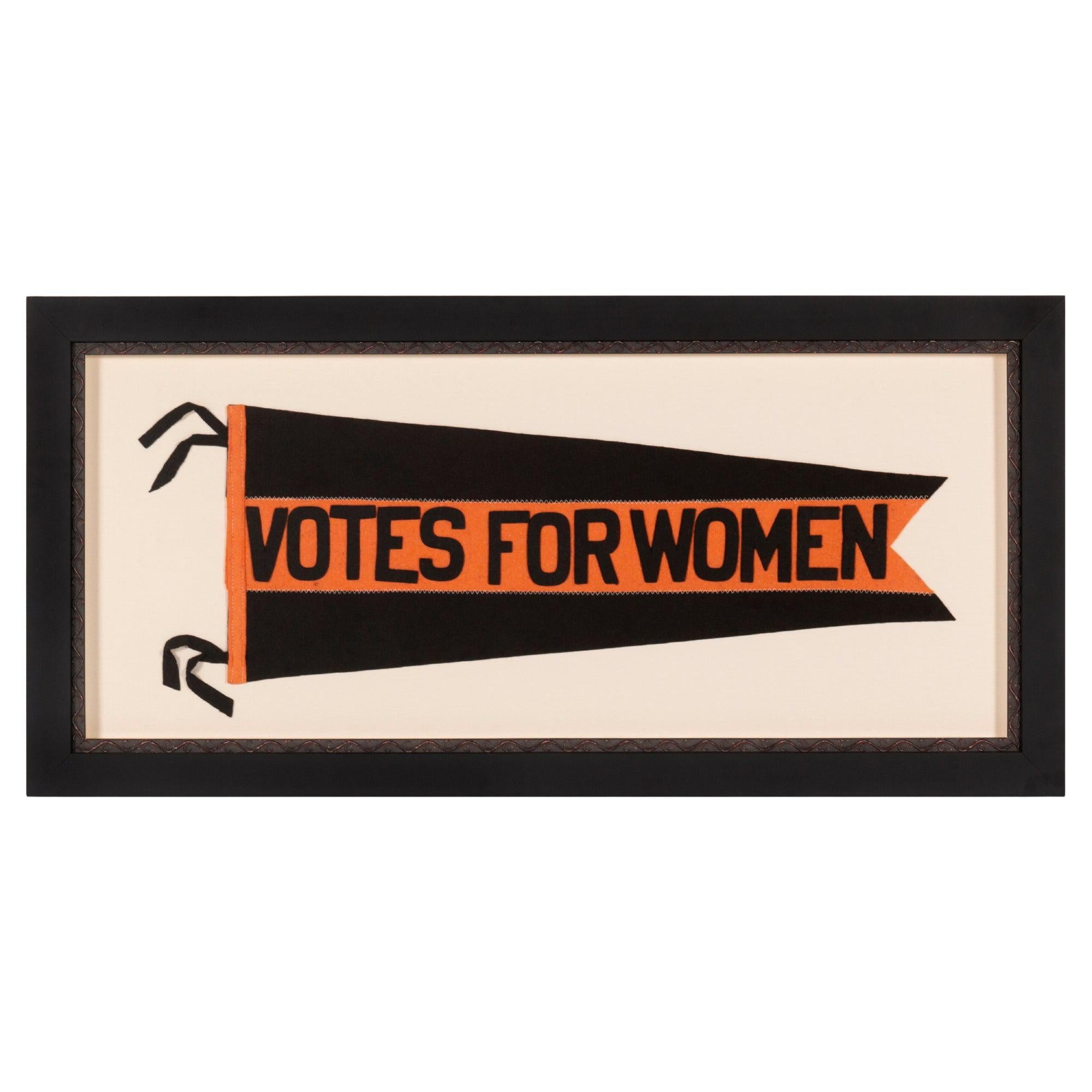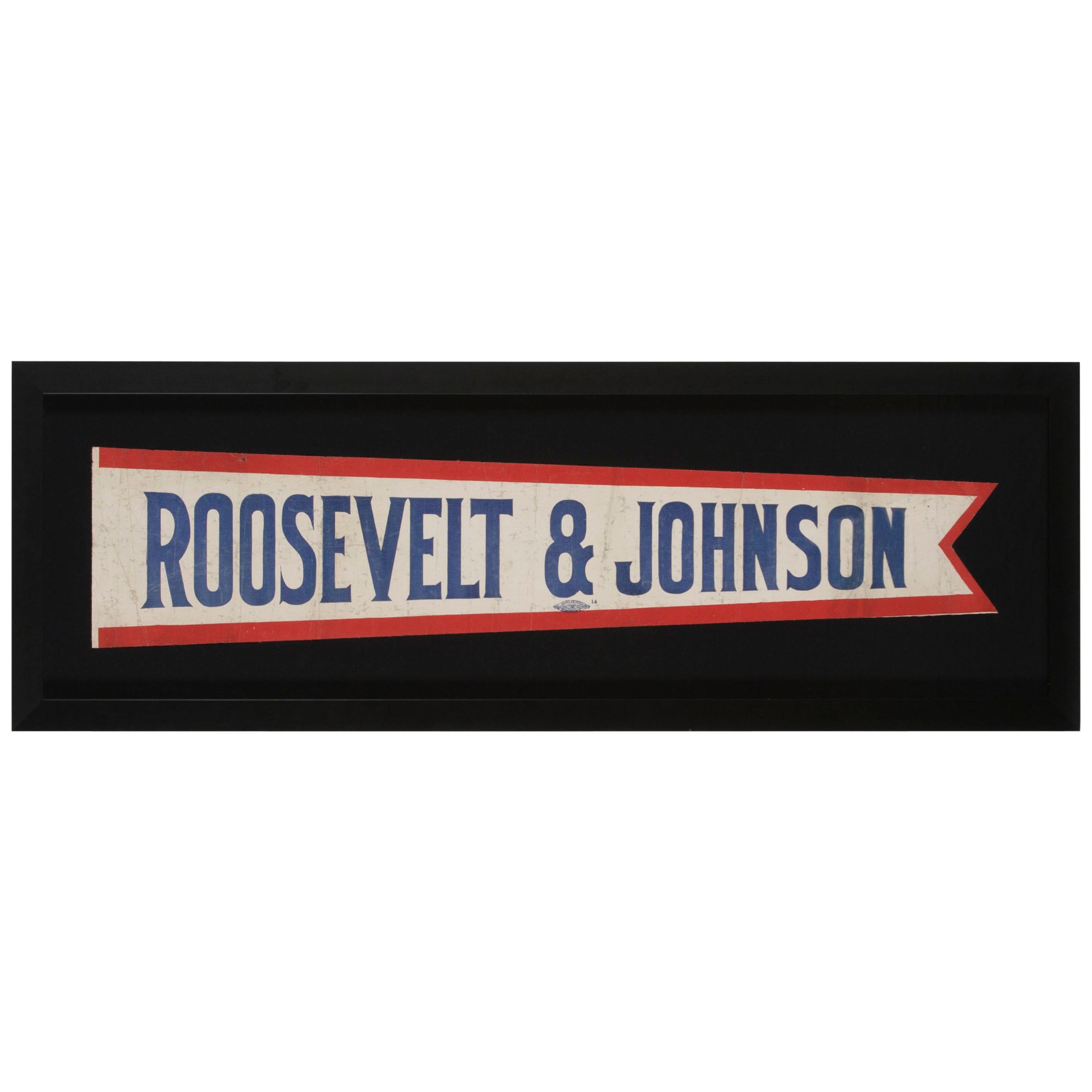Items Similar to "Votes for Women: Suffrage Pennant ca 1912-1920
Want more images or videos?
Request additional images or videos from the seller
1 of 5
"Votes for Women: Suffrage Pennant ca 1912-1920
About the Item
American Suffrage movement pennant, with a standard, triangular taper. Made of yellow felt, with tapered letters that read simply: "Votes for Women," boldly printed in black pigment. Note how the word “for,” aligned at a steep, downward angle, lends a nice element to the design. A pair of black felt ties are stitched along the hoist.
Golden yellow was the customary color of the suffrage movement in America, a tradition began with the first actual campaign to give women the right to vote. This took place in 1867 in Kansas, the first state to hold a referendum on the issue, when suffragists Susan B. Anthony and Carrie Stanton focused their efforts there and wore sunflowers—the state flower—in a show of support, as well as yellow ribbons. The flower was an appropriate emblem for a rising sun and growth, which led to its use in other states, and the carryover of the color to many other objects of the campaign for years to come. In England, green, white, and violet—the names reflecting the letters GWV, from the slogan or chant, “give women the vote”—were the colors of the movement. Various groups used these also in the States, sometimes substituting golden yellow for green or violet, and sometimes with all of the colors represented.
Mounting: The flag was mounted and framed in our own conservation department, which is led by expert staff. We take great care in the mounting and preservation of flags and have framed thousands of examples.
The pennant has been hand-stitched to 100% cotton twill, black in color, that was washed and treated for colorfastness. The mount was then placed in a concave molding with a very dark brown finish, almost black, with reddish undertones and highlights, to which a black-painted, hand-gilded and distressed, Italian molding, was added as a cap. The glazing is U.V. protective acrylic (Plexiglas)
Condition: Excellent.
- Dimensions:Height: 16.75 in (42.55 cm)Width: 31.25 in (79.38 cm)Depth: 2 in (5.08 cm)
- Materials and Techniques:
- Place of Origin:
- Period:
- Date of Manufacture:1912-1920
- Condition:See Item Description.
- Seller Location:York County, PA
- Reference Number:
About the Seller
5.0
Recognized Seller
These prestigious sellers are industry leaders and represent the highest echelon for item quality and design.
Established in 1991
1stDibs seller since 2008
61 sales on 1stDibs
Typical response time: 10 hours
- ShippingRetrieving quote...Ships From: York County, PA
- Return PolicyThis item cannot be returned.
More From This SellerView All
- Carrie Chapman's "Woman Suffrage Party" Pennant, New York City, ca 1912-1920Located in York County, PA"VOTES FOR WOMEN" PENNANT WITH AN IMAGE OF A 1911 STATUETTE CALLED "SUFFRAGIST" BY ELLA BUCHANNAN, MADE FOR CARRIE CHAPMAN CATT'S "WOMAN SUFFRAGE PARTY" OF NEW YORK CITY, CA 1912-20 ...Category
Mid-20th Century American Political and Patriotic Memorabilia
MaterialsCotton
- Rare Yellow & White Suffrage Parasol with "Votes for Women" TextLocated in York County, PAEXTRAORDINARILY RARE, YELLOW & WHITE, SUFFRAGE PARASOL / UMBRELLA, WITH “VOTES FOR WOMEN” TEXT, DISTRIBUTED BY THE NATIONAL AMERICAN WOMEN’S SUFFRAGE ASSOCIATION UNDER ANNA HOWARD SHAW’S LEADERSHIP [HEADQUARTERED IN NEW YORK], CIRCA 1913-1915: In the world of Suffrage memorabilia, parasols and umbrellas are known to have been produced, but hardly any exist. Made in both Britain and America, most of the organizations known to have commissioned them did so with white or purple, green, and white, utilizing the traditional British colors. In America, some of these can be identified to the Women’s Political Union of New York, New Jersey, and Connecticut. As for those in the traditional American colors of golden yellow and white, typically with black text, examples are known to have been produced and sold by the National American Women’s Suffrage Association (NAWSA), beginning in the summer of 1913. According to author and expert Ken Florey, the organization peddled them for “one dollar each or ten dollars a dozen…[promoting] them as good for advertising the cause at street meetings, summer resorts, and county fairs. The design consisted of yellow and white in alternate sections, with “Votes for Women” in the white sections.” Florey goes on to explain how some umbrellas in this style are known with names of states hand-painted in the yellow panels. I am aware of Oregon and Idaho. Florey also indicates that one is known for Alaska. His discussion of the subject, and an illustration of the Idaho example, appear in his book, "Women's Suffrage Memorabilia" (2013, McFarland & Co., North Carolina), on pp. 192 and A8, respectively. The Oregon example, which have seen and held first-hand, is illustrated in "The Keynoter: Journal of the American Political Items Conservators," Summer/Fall/Winter 2008 (Women's Suffrage Special Triple Issue), Vol. 2008, No. 2-4, p. 110. In “Woman Suffrage Memorabilia,” Florey describes a heavy demand for parade accoutrements in the 19-teens. Despite the supposed numbers in which these yellow and white umbrellas were likely to have been produced, this is the only example that I am aware has actually surfaced with the “Votes for Women” text only and no state names. This makes it far more universally desirable. A period image survives in the Albert R. Stone Negative Collection, Rochester Museum & Science Center (Rochester, New York,) of a women carrying parasols in this style on Main Street West in that city on August 15, 1914. The marchers, masked, were described as wearing yellow dominoes (nun-style dresses) and carrying yellow parasols. According to museum catalogers, “The outside parasols are plain; those on the inside have the inscription, "Votes for women". The first group, in yellow and blue dominoes, advertised the speech and visit of Dr. Anna Howard Shaw [this would be members of the Empire Campaign Committee]. The second group carried placards with the names of equal suffrage states and the dates when they adopted votes for women. The Club Theatre, whose sign advertising "Burlesque" is clearly visible behind the marchers, occupies the premises at 75 Main Street West formerly occupied by the Shubert Theatre.” The National American Women’s Suffrage Association was formed in 1890. It represented a merging of the two largest Suffrage groups in America before that time. These were the National Woman Suffrage Association (NWSA), formed in 1869 by Susan B. Anthony and Elizabeth Cady Stanton, and the American Woman Suffrage Association (AWSA), also formed in 1869 by Lucy Stone and her Husband, Henry Brown Blackwell, Henry Ward Beecher, and others. Stone’s daughter, Alice Stone...Category
Mid-20th Century North American Political and Patriotic Memorabilia
MaterialsCotton
- Swallowed Tailed, Suffragette Pennant in Black and Orange, ca 1912-1920Located in York County, PALarge, swallow tailed, suffragette pennant in a black & orange color combination unique to this example, with applied lettering that reads "Votes for Women” down a wide, central stri...Category
Mid-20th Century American Political and Patriotic Memorabilia
MaterialsFelt, Cotton
- Paper Suffrage Pennant with Bold and Whimsical Western Style Lettering, ca 1915Located in York County, PAUnusual paper suffrage pennant, with bold and whimsical, western style lettering, circa 1915 American Suffragette pennant, in a very rare format, with text that reads “Votes for Women,” in a combination of two bold, Western-style fonts. Made of golden yellow paper, with the lettering printed in black, the profile is an unusual one. Linear for approximately 2/5 of its length, the remainder tapers to a point. An example in this style is documented in "The Keynoter: Journal of the American Political Items Conservators," Summer/Fall/Winter 2008 (Women's Suffrage Special Triple Issue), Volume 2008, Number 2-4, p.133. This periodical is the best printed reference that presently exists on Suffrage objects. Golden yellow was the customary color of the suffrage movement in America, a tradition that began with the first actual campaign to give women the right to vote. This took place in 1867 in Kansas, the first state to hold a referendum on the issue when suffragists Susan B. Anthony and Carrie Stanton focused their efforts there and wore sunflowers—the state flower—in a show of support, as well as yellow ribbons. The flower was an appropriate emblem for a rising sun and growth, which led to its use in other states, and the color carried over to many other objects employed in the campaign for years to come. In England, green, white, and purple / violet were introduced in 1908 and became the colors of the movement, which gave way to a nice acronym for “Give Women the Vote.” Various groups used these colors also, in the States, sometimes substituting golden yellow for green. Mounting: The textile was mounted and framed within our own conservation department, which is led by expert staff. We take great care in the mounting and presentation of flags and related textiles and have preserved thousands of examples. This is a pressure mount...Category
Vintage 1910s American Political and Patriotic Memorabilia
MaterialsPaper
- "Votes for Women" Sash in Yellow and White, ca 1910-1915Located in York County, PASilk suffragette sash ribbon in yellow & white with "votes for women" text, circa 1910-1915 Section of wide, silk, grosgrain ribbon, of the type often worn as a sash, in a deep, s...Category
Vintage 1910s American Political and Patriotic Memorabilia
MaterialsSilk
- Elongated Pennant Made for the 1912 Presidential Campaign of Roosevelt & JohnsonLocated in York County, PAELONGATED PENNANT MADE FOR THE 1912 PRESIDENTIAL CAMPAIGN OF THEODORE ROOSEVELT & HIRAM JOHNSON, WHEN THEY RAN ON THE INDEPENDENT, BULL MOOSE / PROGRESSIVE PARTY TICKET: Elongated,...Category
Vintage 1910s American Political and Patriotic Memorabilia
MaterialsCotton
You May Also Like
- US Air Corps in Australia Vintage Military Pennant, circa WWIILocated in Colorado Springs, COPresented is a souvenir felt pennant celebrating the servicemen and women of the U.S. Air Corps who were based in Australia and fought alongside members of the Royal Australian Air Force during WWII. The navy pennant features a printed red outline of the Australian continent with the U.S. Air Corps “wings” superimposed on it. Below, the text reads, “Souvenir of U.S. Air Corps in Australia.” At the very bottom of the pennant is the U.S. Air Corps symbol. Framed according to archival standards, this pennant symbolizes the collaborative partnership between the United States and Australia during the height of the Second World War in the Pacific Theater. Following the swift Japanese conquest of the Philippines and East Indies in late 1941, the remaining servicemen of the United States Army Air Force in the Pacific eventually relocated to Australia, to join other US and Australian units, including the Fifth Air Force, and regroup. The Fifth Air Force was placed under the command of Major General George Kenney in July of 1942. Their new goal was to seize air superiority over New Guinea and gain back air coverage over the Solomon Sea. General Kenney worked with U.S. Army General MacArthur...Category
Vintage 1940s Australian Historical Memorabilia
MaterialsFelt
- French Women Bust Sculpture "Marianne" Godess of Liberty in Solid Wood, 1960sLocated in Antwerp, BEVintage French bust sculpture of a woman Marianne has been the national personification of the French Republic since the French Revolution, as a personification of liberty, equality, fraternity and reason, and a portrayal of the Goddess of Liberty...Category
Vintage 1960s French Mid-Century Modern Busts
MaterialsWood
- Antique Reverse Printed Commemorative Panel for Admiral Lord Nelson's DeathLocated in Hamilton, OntarioThis framed antique and reverse printed panel was produced in England in the early 20th century by an unknown maker to commemorate the death of Admiral Lord Nelson...Category
Early 20th Century English Edwardian Prints
MaterialsPaper
- 41-Star Printed Flag Waver, Celebrating Montana Statehood, 1889Located in Colorado Springs, COPresented is a very rare, 41-star flag waver celebrating Montana statehood. The flag is printed on linen and dates to 1889. The dark blue canton is printed with forty one stars in nine rows of alternating counts of five and four stars. Thirteen red and white stripes complete the flag’s design. The history of Montana statehood is a long one. Numerous Native American tribes originally inhabited the Montana Territory. Meriwether Lewis, William Clark, and the members of their expedition were the first explorers to document a journey through Montana and the lands of the Louisiana Purchase. Soon, forts were established to facilitate regular fur trading with Native American tribes. Missionaries and trailblazers followed. The discovery of gold in the early 1860s sped the creation of the Montana Territory. As settlers and gold prospectors entered Montana in the 1860s and 1870s, conflicts with the Native Americans arose. Perhaps the most famous clash between Native Americans and the United States military occurred in Montana on June 25, 1876. On that day, Sioux and Cheyenne defeated Lieutenant Colonel George Armstrong Custer‘s 7th United States Cavalry regiment at the Battle of the Little Bighorn. A year later, Nez Percé Chief Joseph surrendered in the Bear Paw Mountains of Montana. Lured by copper in the 1880s, mining brought even more settlers to Montana. Rich grazing lands for cattle and sheep attracted other pioneers. Each of the states in America, with the exception of the original thirteen, Texas, and California, was first organized as a territory before achieving admittance to the Union as a state. Originating with the Ordinances of 1785 and 1787, the territorial system provided the expanding U.S. with a method to govern frontier areas until they gained sufficient population and economic maturity to qualify for statehood. Not surprisingly, residents of frontier territories usually demanded quick admission to statehood so they could gain full control of their local governments. Montana was a territory for 25 years – from the creation of Montana Territory in 1864 until the territory was admitted to statehood in 1889. On November 2, 1889, North and South Dakota were added to the Union as the 39th and 40th states, the first time in history that two states were admitted on the same day. Montana became the 41st state on November 8, predating Washington, the 42nd state, by only three days. Flag makers were not in the business of making out-of-date flags. As a result of these rapid changes in the number of states, only a small number of 41-star flags or commemorative items were ever produced, thereby making any 41-star flag exceedingly rare. CONDITION: Good condition. This flag is printed, with a hemmed headband and fly end in a running stitch...Category
Antique 1880s American Political and Patriotic Memorabilia
MaterialsLinen
- Vintage Italian Flag c.1940 (FREE SHIPPING)By American Flag & Banner Co.Located in San Francisco, CAABOUT An original Italian flag with brass grommets to hang it. CREATOR American Flag and Banner Company, San Francisco. DATE OF MANUFACTURE c.19...Category
Early 20th Century Industrial Political and Patriotic Memorabilia
MaterialsBrass
- 1889 North Dakota 39 Star United States of America Statehood FlagLocated in Coeur d'Alene, ID39 star silk statehood flag. 23 1/2" x 15". Was the unofficial North Dakota Flag. As South Dakota was also admitted as the 40th state on the same day this...Category
Antique 1880s American Historical Memorabilia
MaterialsSilk
Recently Viewed
View AllMore Ways To Browse
Colors For Antique Furniture
Womens Movement
Women Used As Furniture
Used Patriotic Memorabilia
Memorabilia Patriotic Political
Antique Political Memorabilia
Antique Patriotic Memorabilia
Women Tie
Womens Tie
United States Framed Flag
Framed Patriotic Flag
Antique Framed American Flag
Antique American Flag Framed
Antique State Flags
Antique Hoist
Womens Caps
Antique Italian Flag
Women Vote





